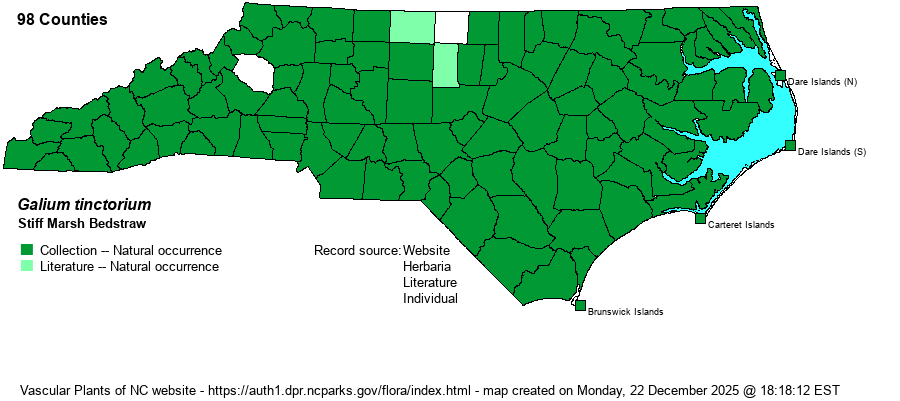| Author | L. | |
| Distribution | Statewide, and almost certainly occurring in all 100 counties.
This is a widespread Eastern species, ranging from eastern Canada south to the Gulf Coast to central TX and FL. | |
| Abundance | Frequent to common throughout, probably more numerous in the Coastal Plain than elsewhere. | |
| Habitat | This is a wetland species, with similar habitats to those of G. obtusum. It occurs in swamp openings, wet meadows, marshes, and bottomland openings and edges. | |
| Phenology | Blooms from April to June, and fruits from June to August. | |
| Identification | This is a very weak herb that leans on other vegetation or droops along the ground, reaching about 1.5 feet long, with several branches. The stems have some retrorse hairs. This species has leaves mainly in whorls of 5-6, at times 4, but the leaves are not equally/geometrically arranged around the stem, but tend to be somewhat irregularly arranged. They are quite thin in texture and linear in shape, about 2/3-inch long but barely 1/8-inch wide. The tiny white flowers are usually in groups of 3, mostly in terminal clusters. G. triflorum has leaves in whorls of 6, but they are elliptical in shape and are equally spaced around the axis of the stem. G. aparine has extremely scabrous stems with an abundance of retrorse, stiff hairs, with longer leaves, usually in whorls of 8. | |
| Taxonomic Comments | Weakley (2018) lists two varieties in the state -- var. floridanum occurs mostly in the Coastal Plain but does range farther west, whereas var. tinctorium is more a taxon of the Mountains and Piedmont.
| |
| Other Common Name(s) | Three-lobed Bedstraw | |
| State Rank | S5 | |
| Global Rank | G5 | |
| State Status | | |
| US Status | | |
| USACE-agcp | FACW link |
| USACE-emp | OBL link |

